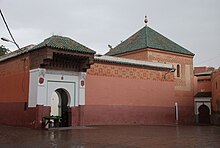Abdallah al-Ghazwani
| Moroccan literature |
|---|
| Moroccan writers |
|
| Forms |
|
| Criticism and awards |
|
| See also |
|
Abu Mohammed Abdallah al-Ghazwani (Arabic: أبومحمد عبدالله الغزواني) (died in 1529) was a Sufi saint from Morocco in the tradition of al-Jazuli and ash-Shadhili. He was the successor of Abdelaziz al-Tebaa. Some two hundred years after his death he became one of the Sabaatou rijales, the seven saints of Marrakesh, an institution founded by al-Yusi at the instigation of sultan Moulay Ismael (1672–1727). Abdallah al-Ghazwani wrote on the idea of the Tariqa Muhammadiyya. Al-Ghazwani combined Ibn Arabi’s and al-Jili’s ideas of the saint's absorption (or annihilation) in the Muslim essence (dhat) with an emphasis on the necessity of the saint's involvement in society.[1] Al-Ghazwani was also renowned for his skill in sinking wells and constructing channels.[2]
Notes[]
- ^ Vincent Cornell, Realm of the Saint, Power and Authority in Moroccan Sufism (Austin: University of Texas Press, 1998), pp. 219, 227.
- ^ Francisco Rodriguez-Manas, Agriculture, Sūfism and the State in Tenth/Sixteenth-Century Morocco, Bulletin of the School of Oriental and African Studies, University of London, Vol. 59, No. 3 (1996), pp. 450-471
References[]
- Hasan Jallab, Abu Muhammad Abdullah Al Ghazwani, Morocco: Imprimerie et Papeterie Nationale, 2005 (Biography of Al Ghazwani) ISBN 978-9954-0-0405-0
- Moroccan Sufi writers
- 1529 deaths
- People from Marrakesh
- 16th-century Moroccan people
- Moroccan writer stubs
- Sufism stubs
